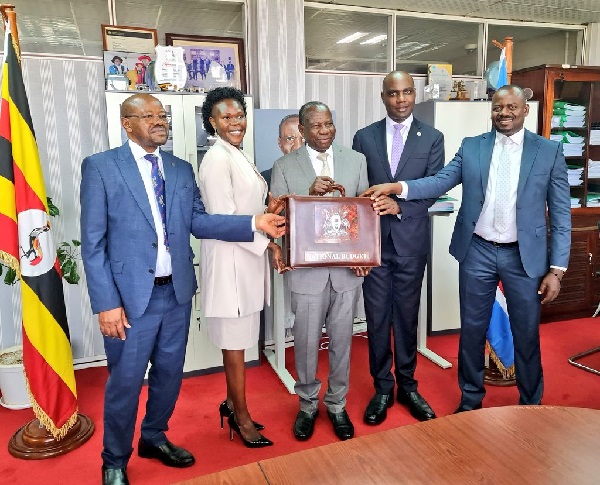
Kampala, Uganda | THE INDEPENDENT | The Minister of Finance, Planning and Economic Development, Matia Kasaija says the government will strive to achieve double-digit economic growth.
Economic growth refers to an increase in the aggregated production and market value of economic commodities and services in an economy over a specific period. Increased productivity translates to higher income, more consumption of goods, and improved quality of life across the country.
Kasaija said this budget will set the foundation for implementing the government’s strategy for expanding the size of the country’s Gross Domestic Product (GDP) from about USD 50 billion in the financial year 2023/2024 to USD 500 billion by the year 2040.
Some of the benefits of double-digit economic growth include higher income, reduced poverty, better facilities, and improved quality of life.
Speaking during the presentation of the next financial year’s budget, Kasaija said Uganda met the requirements to graduate from the category of Least Developed Countries (LDCS). He said Uganda also moved from the category of low human development to medium human development.
This year’s Budget is under the theme “Full Monetization of Uganda’s Economy through Commercial Agriculture, Industrialization, Expanding and Broadening Services, Digital Transformation and Access”
The budget for the financial year 2024/2025 is the last to implement the National Development Plan (NDP III).
He stated the medium priorities and strategies for growing the economy ten-fold starting with the financial years 2024/2025. Kasaija reported that Uganda’s economy has fully recovered from the various internal and external shocks like the effects of the COVID-19 pandemic that affected performance in the past four years. The Gross Domestic Product is projected to grow by 6% this financial year compared to 5.3% percent in the financial year 2022/2023.
Because of this robust growth, Kasaija said the size of the economy is now estimated at 202 trillion shillings or 52.3 billion dollars. The size of the economy was previously estimated at 194.3 trillion shillings.
“If Ugandans agreed to share this GDP equally, each citizen would enjoy a GDP per capita of USD 1,146 compared to USD 1,081 registered last Financial Year 2022/23,” he said.

The Finance Minister said the improved performance of the economy is on account of higher growth in all sectors. He said services like agriculture and industry are expected to grow by 6.6%, 5.1% and 5.8% respectively. He said growth in the services sector has particularly been impressive.
Driven by strong recovery in retail and wholesale trade, tourism as well as communication and real estate. Growth in the industry was driven by manufacturing, construction, and mining.
He said Uganda’s inflation is one of the lowest. “Annual headline inflation has reduced from the peak of 10.7% in October 2022 to 3.6% last month. The reduction has been a result of good coordination of monetary and fiscal policies leading to low inflation of all food crops, manufactured goods and essential commodities like laundry bar soap sugar and cooking oil.”
Interest rates
The Commercial Bank lending rate for shilling-dominated credit reduced to 17.7% in April 2024 compared to 19.3% in April 2023. “Interest rates in the domestic debt market have remained broadly stable averaging 11.2% on the one-year government treasury bills.
He said to further reduce lending rates; Kasaija said the government will continue to provide long-term capital through various interventions.
“In particular, the government will continue to capitalize Uganda Development Bank, the Parish Development Model, the Agricultural credit facility, and the Small Business Recovery Fund,” Said Kasaija.
He further revealed that the government is continuing with the capitalization of the Emyoga fund to support micro-enterprises as well as the presidential skilling and industrial hubs for the youth. “Grants will also be extended to woe in business through the generating growth opportunity for women enterprises,” Kasija added.
The Minister outlined Uganda’s growth strategy for the next financial year. He said in the medium term, it is anchored on four key growth drivers.
Those include Agro-industrialisation; Tourism development; Mineral development including oil and gas; and Science, technology and innovation (STI).
According to Kasaija, those anchor sectors will propel Uganda to a 500-billion-dollar economy in the next one-and-a-half decades.
He however said Uganda has to deal with several challenges which include climate, regional and global geopolitical tensions, and high interest rates among others.
According to the Finance Ministry, by the end of the next five years, the NDP4 currently under finalisation will add 450 billion dollars to leave the country at a super economic level of 500 billion dollars (10 times where it is today).
This would put the economy just below Israel, Norway, and Singapore by their current GDP figures, and above the Philippines, Vietnam, Iran, Bangladesh, Malaysia and Denmark, as well as, of course, South Africa and Nigeria, going by the IMF 2024 figures.
With an estimated 8 million people to be added to the current population, the GDP per capita will rise from the current estimate of about 1,081 to 8,300 US dollars.

Background to the new budget shows that the economy sustained recovery from the effects of COVID-19, growing at about 6 percent in 2023/2024, which was faster than the 5.3 percent recorded for last year, and the 4.6 percent for the year earlier.
Subsequently, the per capita GDP in 2023/2024 is estimated at about 1,146 US dollars compared to 1,081 dollars in the financial year, 2022/2023.
In coming up with these 2024/2025 targets, the government hopes to increase domestic revenue collection from the 27 trillion shillings that URA expected to have collected by June 30th this year, to about 32 trillion shillings next year.
According to the minister, the resources available for expenditure next financial year and in the medium term will be obtained from both domestic and external sources.
“This will include domestic revenue (tax and non-tax revenue), draw down from the petroleum fund, domestic borrowing, budget support grants and loans, as well as project support (grants, concessional and non-concessional loans),” it says.
The resource envelope net of arrears and domestic debt repayments is projected to amount 37.829 trillion shillings.
Other strategic objectives and actions include the reduction of total public debt in nominal terms to below 50 percent of GDP by financial year 2025/26, as per the Charter of Fiscal Responsibility.
It also aims to gradually adjust the overall fiscal balance including grants to a deficit not exceeding 3 percent of GDP (excluding the oil contribution), by 2025/26.
The charter also targets transferring a maximum of oil revenues worth 0.8 percent of the preceding year’s estimated non-oil GDP outturn to the Consolidated Fund for budget operations.
The balance is to be transferred to the Petroleum Revenue Investment Reserve (PRIR) for investment by the Public Finance Management Act (PFMA) (2015) as amended.
To achieve these, the government will have to ensure interventions to increase domestic revenue mobilization, reduce wasteful expenditures, reduce “inefficiencies in the health and education sectors”, improve project implementation efficiency, and reduce borrowing from external commercial sources, among others.
The expected increase in domestic revenues is pegged on an anticipated increase in economic growth, new tax revenue measures and improved tax compliance and administration.
This is on account of new recruitments at the URA and the introduction of digital systems for tax collection such as the Electronic Fiscal Receipting and invoicing Solutions (EFRIS).
The government is also aware that resources in form of grants and concessional loans are projected to reduce significantly from 2.78 trillion in 2023/2024 to 1.394 billion next financial.
“This reduction is due to government’s deliberate decision to reduce commercial external borrowing in an effort to maintain fiscal and debt sustainability,” it says.
Yet, amortisation of external debt is projected to increase from 2.638.6 trillion as approved in the approved budget for 2023/2024 to 3.108 trillion shillings next year, (equivalent to 1.4 percent of GDP).
It is expected to continue rising to an average of 1.9 percent of GDP by 2028/2029.
***
URN
 The Independent Uganda: You get the Truth we Pay the Price
The Independent Uganda: You get the Truth we Pay the Price



